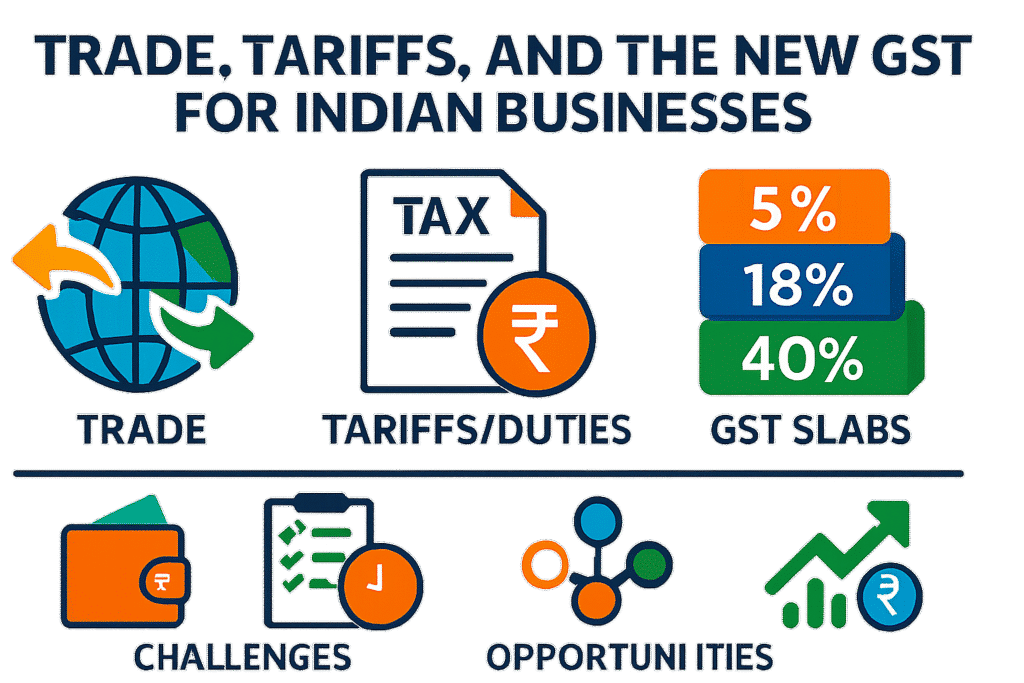Introduction
India’s business environment is undergoing a significant transformation in 2025, marked by the introduction of the new GST 2.0 regime and ongoing changes in international trade tariffs. These developments present a complex mix of challenges and opportunities for Indian businesses, especially in sectors reliant on both domestic consumption and global markets. This blog explores how the revamped GST and evolving tariff landscape impact trade and what businesses can do to navigate this environment effectively.
The New GST 2.0: Simplifying Taxation for Better Compliance
In September 2025, the Indian government rolled out GST 2.0, streamlining GST slabs from four to primarily two main rates: 5% on essentials and 18% on most goods and services, with a 40% demerit rate for luxury and sin goods. This rationalization simplifies tax compliance, reduces disputes, and accelerates refund processes for exporters. For trade-related businesses, this means lower compliance costs, better cash flow, and a more transparent business model.
Tariff Shifts: The Double-Edged Sword
While GST reform is domestically positive, Indian exporters face global tariff uncertainties. The US, a key export market, imposed increased tariffs of up to 50% on select Indian goods in 2025, particularly targeting textiles, auto components, and chemicals. Such tariffs threaten export volumes and profit margins, compelling businesses to rethink supply chains and market diversification. At the same time, some tariff reductions in ASEAN markets offer new openings for Indian exporters. This dynamic environment calls for agility and strategic planning.
Key Challenges for Indian Businesses
- Upfront Cash Flow Pressures: Importers must pay integrated GST upfront, even as input tax credits are claimable later, straining working capital.
- Tariff-Driven Export Risks: High tariffs in markets like the US reduce competitiveness and shake established business relationships.
- Compliance and Digital Transition: While GST 2.0 simplifies tax rules, firms must upgrade systems and train staff for digital filing and faster refund mechanisms.
- Luxury Goods and Sin Products: Higher GST and tariff rates on luxury and sin goods squeeze margins for businesses in these segments.
Emerging Opportunities
- Boosted Domestic Demand: Lower GST rates on essentials and consumer goods stimulate local consumption, benefiting retailers, FMCG, and manufacturing sectors.
- Improved Export Competitiveness: Simplified GST refunds and aligned tax rates reduce production costs, supporting exporters in non-tariff-affected sectors.
- MSME Empowerment: Reduced compliance complexities and digital filing empower small and medium businesses to scale and formalize operations.
- Global Trade Diversification: Tariff challenges encourage businesses to explore new markets in Europe, the Middle East, and Africa, diversifying risk and expanding footprints.
Strategies for Navigating the New Landscape
- Adopt Digital Compliance Tools: Invest in GST-compliant ERP systems and stay updated on tax changes to avoid penalties and delays.
- Reevaluate Supply Chains: Explore alternate sourcing and markets to mitigate tariff impact and leverage trade agreements.
- Focus on Value Addition: Enhance product quality and branding to justify slightly higher prices in tariff-affected markets.
- Leverage Government Schemes: Utilize MSME support programs, export incentives, and GST refunds to improve cash flow and competitiveness.
Conclusion
The combined impact of GST reform and shifting trade tariffs in 2025 presents a challenging yet opportunistic environment for Indian businesses. Success will depend on adaptability, strategic planning, and harnessing the benefits of simplified taxation while navigating global trade complexities. Businesses that embrace digital tools, diversify their markets, and focus on value addition will be well-positioned for growth in this evolving landscape.

